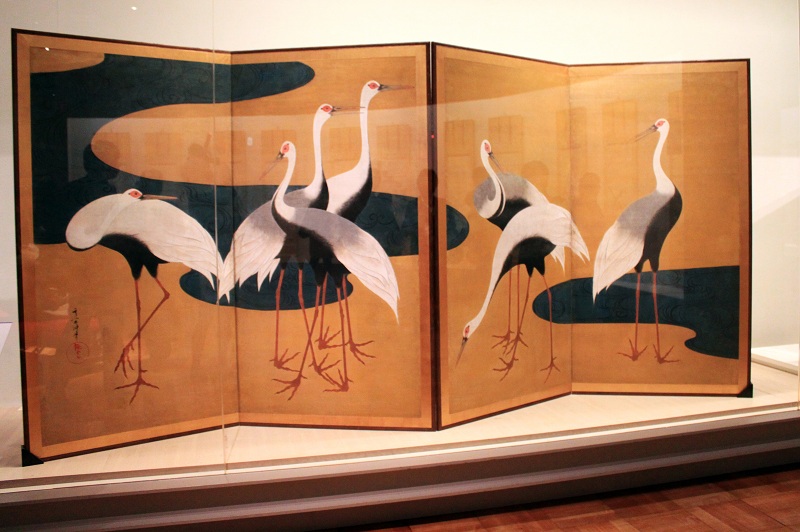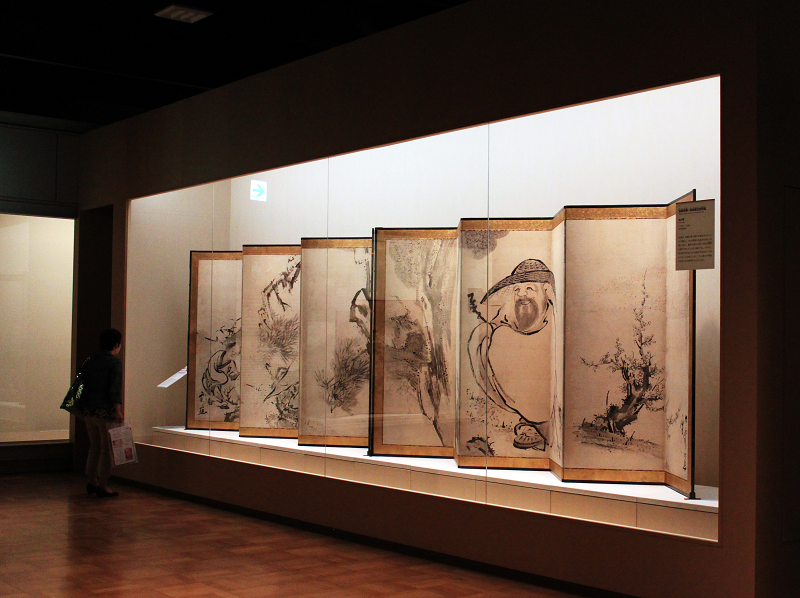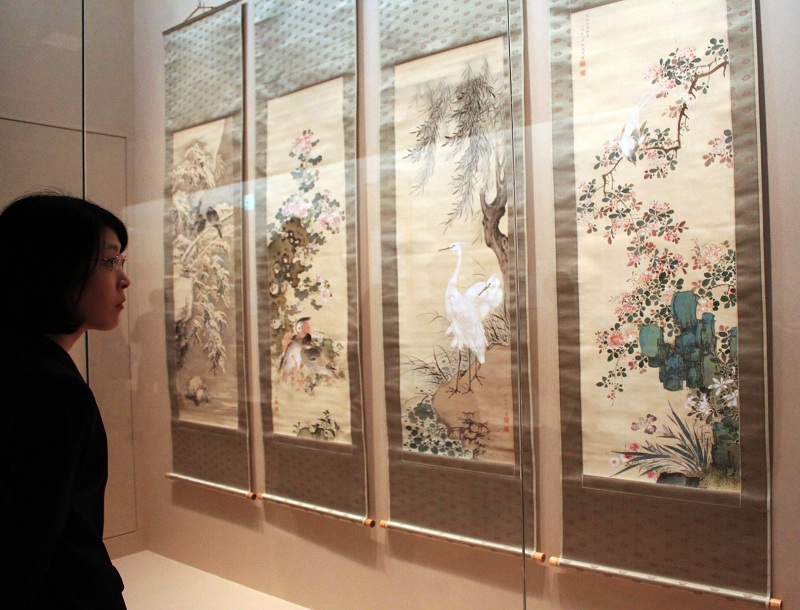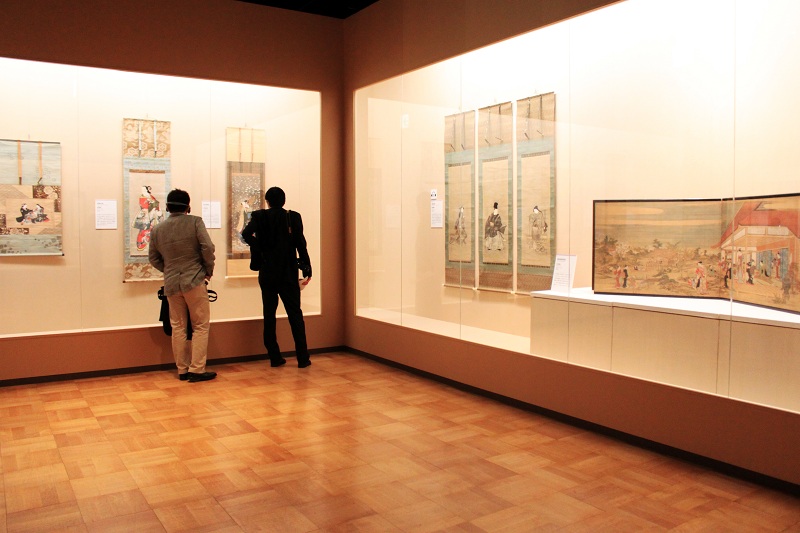The Flowering of Edo Period Painting: Japanese Masterworks from the Feinberg Collection
- Published 2013.5.24

The average person probably associates Edo period (1603-1867) art with popular, mass-produced woodblock prints ŌĆō Hokusai's The Great Wave being most famous ŌĆō but the painting of this era is no less beautiful or impressive.Held at the Edo-Tokyo Museum, this exhibition sees some 90 masterworks of the Feinberg collection that showcase the creativity and diversity of Edo period painting.
Amassed over a brief 40 years by Maryland-based Dr. Robert and Betsy Feinberg, this private collection is unusual that it contains no paintings from the popular and dominant Kano and Tosa schools. Though these schools of painting were originally quite grand and innovative in the preceding Azuchi-Muromachi period, by Edo they had become largely stale and derivative. The Feinberg collection is comprised of bold and creative works by artists from independent schools, unconstrained by stylistic and artistic conventions.
Organised into five sections by school, the exhibition begins with Rinpa art, moving quite seamlessly through to bunjinga (literati/Southern School painting); the Maruyama-Shij┼Ź school and the Eccentrics follow, and it finishes with ukiyo-e painting. Amazingly, though the Feinbergs can neither read nor speak Japanese, they managed with scant assistance from experts to amass a quality collection without a single fake in it.
For me, the bunjinga section stood out with its excellent and sometimes rather unusual works. Walking into the literati painting section, you are met with a pair of large-format six-panel folding screens (pictured below), Meng Jia Loses His Hat and The Poet Su Shi by Ike no Taiga (1723 ŌĆō 1776), who was a virtuoso when it came to the brush. It is a piece to be admired for its bold, spirited brushwork ŌĆō and the slightly humorous figures depicted. Directly opposite is Bamboo on a Windy Day, a small fan painting by Tokuyama Gyokuran. Almost abstracted bamboo stems sway in the wind across the surface of this fan. Inscribed with a poem in elegant, delicate calligraphy, the piece is minimalist, with a rather modern sensibility.

It was also fun and edifying to compare two different treatments of the subject matter. Ki no Baitei's version of Poetry Gathering at the Lanting Pavillion is like a Where's Wally in sumi - almost every inch is covered in darker shades of ink, every leaf faithfully rendered in minute detail, with little clusters of literati here and there highlighted in orange. It's impressive and beautiful, though perhaps potentially headache-inducing.
Okada Beisanji's interpretation, in contrast, is reminiscent of a fairytale illustration ŌĆō it has a misty, magical feel. Everything from trees to rocks and branches are depicted in soft, flowing lines, and the central river which snakes through the landscape guides our eye downwards in meandering S-lines. Intense, dark tones are kept to a minimum, and we see a landscape awash with gentle greys, blues, greens and hints of orange and brown.

My personal favourite was Watanabe Gentai's Peach Blossom Spring. The mountains in this painting are an intense, bright blue, unusual in a genre that tends to largely be in monochrome. It does not overwhelm the painting, however, instead lending the landscape an air of tranquility. You could spend a good few minutes examining the minutiae of the painting ŌĆō the meticulously detailed scenes of village life, thatched huts, a small pen of swans.
Indeed, this is the case for many of the paintings in this exhibition ŌĆō you find yourself getting lost in the details and the brushwork. It is particularly true for works from the Maruyama-Shij┼Ź school, the hallmark of which is naturalistic depiction with a more decorative bent. Those fond of botanical illustrations will enjoy this section: peacocks, fish, an eagle, monkeys, a dead crane ŌĆō all make an appearance in gorgeous and vibrant colours.
An exhibition on Edo period painting would of course be lacking without those from the ukiyo-e genre. Here we make a sudden leap from landscapes and animals to paintings of beautiful ladies (and the occasional beautiful man). Of interest is the very fun Spring Concert by Utagawa Toyoharu, which demonstrates his interpretation of linear perspective ŌĆō it is a wonderfully improbable scene. The four-sided silk inlays that the artworks themselves are mounted on, too, are beautiful and merit a closer look. They are often decorated or painted with intriguing patterns ŌĆō a fine example would be A Salt Maiden and Envious Courtesan by Utagawa Toyokuni I.
The Flowering of Edo Period Painting: Japanese Masterworks from the Feinberg Collection is being presented for the first time in Tokyo, having previously been exhibited in two other Japanese cities. It is highly worth seeing, though it did end a little too abruptly for my liking. The exhibition will be held in two parts ŌĆō the first running till mid-June and the second till mid-July ŌĆō meaning that some of the works appearing right now may not be displayed after mid-June.
Ample seating is provided throughout the galleries of this special exhibition, as well as the rest of the Edo-Tokyo Museum, there for those in need of a rest. The catalogue for this exhibition deserves a special mention: not only are all the paintings there, it is also bilingual (Japanese-English) ŌĆō a lifesaver if one cannot read the captions. It makes, I think, a fine addition to any library.
The Flowering of Edo Period Painting: Japanese Masterworks from the Feinberg Collection
Edo-Tokyo Museum, 1-4-1 Yokoami, Sumida-ku, Tokyo
Part 1: May 21st ŌĆō June 16th; Part 2: June 18th ŌĆō 15th July, 2013
09:30~17:30 (Saturdays: 09:30~19:30. Last entry thirty minutes before closing.) Closed Mondays.>
Adults: 1300 (1040) yen; university/vocational school students: 1040 (830) yen; seniors and senior/junior high/middle/elementary school students: 650 (520) yen
A list of all the works on display
Recommended links:
Review: Patterned Feathers, Piercing Eyes: Edo Masters From the Price Collection
Review: In Japan, When Word Was Wed to Image [On Ike Taiga and Tokuyama Gyokuran]



